Parental Incarceration
Description
A summary of the scientific literature on the impact of parental incarceration on child development.

Components
Image

How This Impacts Children's Development
Description
Parental incarceration has been linked to an array of consequences for children's development and well-being, spanning most developmental domains and all developmental stages. Families of color are disproportionately affected by incarceration and associated policies.
Talking Points from the SRCD Brief
|
Policy Considerations in the Brief
- Consider policies that move further upstream and identify ways to truly support children, families, and communities and eliminate our country's reliance on the criminal legal system to fix complex social problems.
- Any policy solution requires strong cross-agency collaboration, from health, human services, education, and corrections agencies.
- Individuals with lived experience are uniquely situated to contribute to the development and evaluation of efforts to improve the experiences and well-being of families affected.
- Effective policy solutions must address historical, racial, and economic disparities in all aspects of criminal legal system involvement.